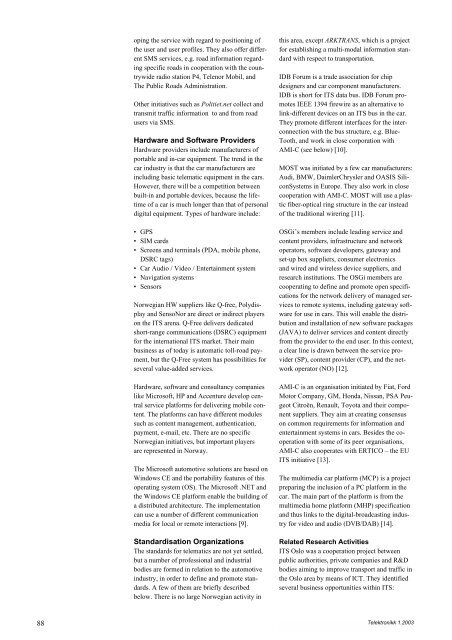Intelligent Transport Systems - Telenor
Intelligent Transport Systems - Telenor
Intelligent Transport Systems - Telenor
Create successful ePaper yourself
Turn your PDF publications into a flip-book with our unique Google optimized e-Paper software.
88<br />
oping the service with regard to positioning of<br />
the user and user profiles. They also offer different<br />
SMS services, e.g. road information regarding<br />
specific roads in cooperation with the countrywide<br />
radio station P4, <strong>Telenor</strong> Mobil, and<br />
The Public Roads Administration.<br />
Other initiatives such as Politiet.net collect and<br />
transmit traffic information to and from road<br />
users via SMS.<br />
Hardware and Software Providers<br />
Hardware providers include manufacturers of<br />
portable and in-car equipment. The trend in the<br />
car industry is that the car manufacturers are<br />
including basic telematic equipment in the cars.<br />
However, there will be a competition between<br />
built-in and portable devices, because the lifetime<br />
of a car is much longer than that of personal<br />
digital equipment. Types of hardware include:<br />
• GPS<br />
• SIM cards<br />
• Screens and terminals (PDA, mobile phone,<br />
DSRC tags)<br />
• Car Audio / Video / Entertainment system<br />
• Navigation systems<br />
• Sensors<br />
Norwegian HW suppliers like Q-free, Polydisplay<br />
and SensoNor are direct or indirect players<br />
on the ITS arena. Q-Free delivers dedicated<br />
short-range communications (DSRC) equipment<br />
for the international ITS market. Their main<br />
business as of today is automatic toll-road payment,<br />
but the Q-Free system has possibilities for<br />
several value-added services.<br />
Hardware, software and consultancy companies<br />
like Microsoft, HP and Accenture develop central<br />
service platforms for delivering mobile content.<br />
The platforms can have different modules<br />
such as content management, authentication,<br />
payment, e-mail, etc. There are no specific<br />
Norwegian initiatives, but important players<br />
are represented in Norway.<br />
The Microsoft automotive solutions are based on<br />
Windows CE and the portability features of this<br />
operating system (OS). The Microsoft .NET and<br />
the Windows CE platform enable the building of<br />
a distributed architecture. The implementation<br />
can use a number of different communication<br />
media for local or remote interactions [9].<br />
Standardisation Organizations<br />
The standards for telematics are not yet settled,<br />
but a number of professional and industrial<br />
bodies are formed in relation to the automotive<br />
industry, in order to define and promote standards.<br />
A few of them are briefly described<br />
below. There is no large Norwegian activity in<br />
this area, except ARKTRANS, which is a project<br />
for establishing a multi-modal information standard<br />
with respect to transportation.<br />
IDB Forum is a trade association for chip<br />
designers and car component manufacturers.<br />
IDB is short for ITS data bus. IDB Forum promotes<br />
IEEE 1394 firewire as an alternative to<br />
link-different devices on an ITS bus in the car.<br />
They promote different interfaces for the interconnection<br />
with the bus structure, e.g. Blue-<br />
Tooth, and work in close corporation with<br />
AMI-C (see below) [10].<br />
MOST was initiated by a few car manufacturers:<br />
Audi, BMW, DaimlerChrysler and OASIS Silicon<strong>Systems</strong><br />
in Europe. They also work in close<br />
cooperation with AMI-C. MOST will use a plastic<br />
fiber-optical ring structure in the car instead<br />
of the traditional wirering [11].<br />
OSGi’s members include leading service and<br />
content providers, infrastructure and network<br />
operators, software developers, gateway and<br />
set-up box suppliers, consumer electronics<br />
and wired and wireless device suppliers, and<br />
research institutions. The OSGi members are<br />
cooperating to define and promote open specifications<br />
for the network delivery of managed services<br />
to remote systems, including gateway software<br />
for use in cars. This will enable the distribution<br />
and installation of new software packages<br />
(JAVA) to deliver services and content directly<br />
from the provider to the end user. In this context,<br />
a clear line is drawn between the service provider<br />
(SP), content provider (CP), and the network<br />
operator (NO) [12].<br />
AMI-C is an organisation initiated by Fiat, Ford<br />
Motor Company, GM, Honda, Nissan, PSA Peugeot<br />
Citroën, Renault, Toyota and their component<br />
suppliers. They aim at creating consensus<br />
on common requirements for information and<br />
entertainment systems in cars. Besides the cooperation<br />
with some of its peer organisations,<br />
AMI-C also cooperates with ERTICO – the EU<br />
ITS initiative [13].<br />
The multimedia car platform (MCP) is a project<br />
preparing the inclusion of a PC platform in the<br />
car. The main part of the platform is from the<br />
multimedia home platform (MHP) specification<br />
and thus links to the digital-broadcasting industry<br />
for video and audio (DVB/DAB) [14].<br />
Related Research Activities<br />
ITS Oslo was a cooperation project between<br />
public authorities, private companies and R&D<br />
bodies aiming to improve transport and traffic in<br />
the Oslo area by means of ICT. They identified<br />
several business opportunities within ITS:<br />
Telektronikk 1.2003
















